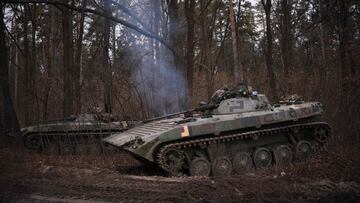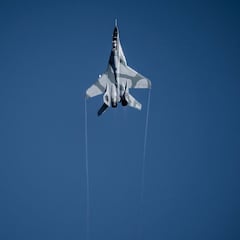What is the military power of the Russian army and how strong is the Ukrainian army?
The Russian army has more weapons and better technology, but the Ukrainian armed forces are defending their homeland against an invading force.


As Russian troops invade Ukraine, seeking to overrun the capital Kyiv and depose the government, the imbalance between the armed forces of the two countries is a major factor in the conflict.
On almost every single metric the Russian forces overwhelm their Ukrainian counterparts in terms of size, strength and the technological level of equipment. There are however a couple of areas where the Ukrainian forces have an advantage. Firstly, the Ukrainian troops are defending their homeland, while the Russian forces are invading their neighbours, who for most Russians are not seen as deadly enemies, but a closely-related people. Secondly, the Russians need to put in place logistics and supply chains to invade, with some footage emerging from Ukraine suggest they are already struggling to do.
Armies march on their stomachs, and in the modern era, on the fuel supplies for their vehicles. Fail to get the logistics right and any invasion of a country will fall to pieces. Just ask Napoleon about the invasion of Russia back in 1812.
A priceless exchange of a brave Ukrainian citizen with Russian army stuck out of fuel. ENGLISH SUBTITLES.
— Ali 🇺🇦🕊 (@aliostad) February 26, 2022
[Thanks to my Ukrainian friend for transcription and translation] pic.twitter.com/Rar3WRXEwD
See also:
- Theories about the mysterious 'Z' on Russian tanks in Ukraine
- Donald Trump jokes about bombing Russia with China-flagged planes
- Can Ukraine join EU and how long would it take?
- How Russia-Ukraine war fits into Biden's State of the Union
- Ukraine's Antonov AN-225 'Mriya', the largest plane in the world, destroyed by Russia
How the Ukrainian and Russian forces compare
Here's an overview of how the two fighting forces stack up:
Troop numbers
Russia has a vast standing army (the world's fifth biggest), with some 900,000 active personnel and a further two million reservists, compared to Ukraine’s 196,000 active troops and 900,000 reservists. However, Russia has only put in place some 200,000 troops around Ukraine for the invasion, meaning the forces are fairly evenly balanced in terms of boots on the ground, and Ukraine has called up all men from 18 to 60 who are able to fight, meaning they may actually have the advantage in terms of sheer number of personnel.
That said, this is a huge Russian force and is far bigger than the forces Russia sent for the first and second Chechen wars and is equivalent in size to the very biggest peacetime operations of the Soviet Union or NATO during the Cold War.
Vehicles, equipment and weapons
Troop numbers however are nothing without firepower to back it up. And here Russia has an overwhelming advantage, having vastly more kit and far better kit than their Ukrainian opponents.
In total Russia’s army boasts around 12,500 tanks, compared to Ukraine’s 2,500, although, once again, Russia haven’t deployed all their tanks for this invasion, so the imbalance in this conflict will be lower than suggested by the overall numbers.
In terms of total vehicles, Russia has around 60,000 military vehicles according to Global Firepower, with Ukraine having some 12,000. However given the Ukrainian army is defending its homeland the actual need for vehicles is far lower than for the Russian forces.
In terms of aircraft, Russia has 1,391 planes compared to Ukraine’s paltry 128 and 821 helicopters to Ukraine’s 55. Worse for Ukraine is the fact that the Russian bombardment of the first days of the war has knocked out much of their ability to actually get planes into the air, with sources on the ground suggesting that Russia has almost complete air superiority. While the stories of the Ghost of Kyiv, a supposed ace Ukrainian MiG-29 fighter pilot who allegedly shot down six Russian planes on the first day of the war may raise spirits of the Ukrainians defending their country, the reality is that Russia controls the skies over Ukraine.
Military budgets
The Russian military budget, at some 45 billion dollars, is ten-times that of Ukraine’s 4.7 billion. Furthermore, the Russian military has had a focus on modernisation since 2008. Ukraine has attempted to upgrade its equipment since the Crimean annexation by Russia in 2014, but despite tripling its defence budget much of their armour and equipment remains old and likely ineffective against modern Russian weaponry.
Other weapons
Ukraine has received an estimated 2,000 NLAW missiles (Next Generation Light Anti-tank Weapon) which have been supplied to the Ukrainian forces by the UK, who developed the armament in conjunction with Sweden.
And these appear to have had some impact, with footage of several destroyed Russian tanks circulating on social media.
Ukraine is also deploying Turkish-made TB2 Bayraktars drones, which have had proven anti-tank success in conflicts in Syria and the Nagorno-Karabakh War in 2020 where it was successfully used by Azerbaijan against Armenian air defense and tanks. How successful they will be against the latest Russian tech is another question, and Russian military sources have said they've already shot down four TB2s. Ukraine bought six of the drones back in 2019.
Ukraine pleading for more military material
The Ukrainian president, Volodymyr Zelenskyy, has made it quite clear how much Ukraine needs military support from its supporters in the West. A senior American intelligence official said the president had said he needed "ammunition" and "not a ride" when the US urged him to get to safety and offered help to do so. At present he is staying put in Kyiv, although has made it clear he expects to be targeted and killed by the Russians.
Defending the homeland
As is being shown in the early days of this war, simply having more material resources does not guarantee instant military success. Reports suggest Putin and the Russian top commanders expected to take Kyiv extremely rapidly with little opposition. That is not proving to be the case, as the Ukrainians put up spirited resistance to the invading forces.
In addition to the weaponry available to an army, of equal importance is the moral of a fighting force (including the cohesion and motivation of the troops) and the conceptual approach of a fighting force (strategy, innovation and military thinking). Whilst Russian forces have both experience and a long history of fighting, there are doubts over the motivation of many of the troops for this Putin-inspired military adventure.
Related stories
The Ukrainian forces on the other hand are defending their homeland against an aggressor. Ukraine has a strong tradition of territorial defence, relying on small insurgent groups fighting local battles against more powerful forces. The Ukrainian insurgent army battled both Nazi forces and then the Soviets, carrying on till 1953, causing tens of thousands of casualties.
Putin's worst fear is that despite the superiority of the Russian forces in terms of manpower and weapons, his troops get bogged down in an interminable war, where despite holding much of Ukraine they are unable to eradicate an insurgency that continues to send Russian troops home in bodybags.

